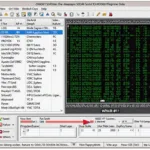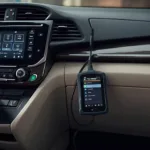OBD1 and OBD2 are two distinct systems for diagnosing vehicle problems. This guide delves into the key differences between OBD1 and OBD2, exploring their functionalities, diagnostic capabilities, and impact on the automotive industry. Understanding these differences is crucial for anyone involved in vehicle maintenance and repair.
Understanding OBD1
OBD1, or On-Board Diagnostics 1, represents the first generation of onboard diagnostic systems. Introduced in the early 1980s, OBD1 systems were manufacturer-specific, lacking standardization. Each car manufacturer implemented its own proprietary connectors, protocols, and diagnostic trouble codes (DTCs). This lack of uniformity made diagnosing vehicle issues across different makes and models a challenge. OBD1 systems primarily focused on monitoring emissions-related components and systems. Retrieving diagnostic information from an OBD1 system typically required specialized tools and knowledge specific to the vehicle’s make and model.
OBD1 systems often relied on flashing check engine lights or other rudimentary indicators to signal a problem. Interpreting these signals required consulting manufacturer-specific documentation or using dedicated diagnostic equipment. Imagine trying to decipher a secret code for each different car you encountered – that’s the essence of working with OBD1. While OBD1 served its purpose in early emissions control, its limitations paved the way for a more standardized and comprehensive system.
Exploring OBD2: The Standardized Solution
OBD2, or On-Board Diagnostics 2, revolutionized vehicle diagnostics with its standardized approach. Mandated in the United States for 1996 and newer model year vehicles, OBD2 quickly became the global standard. This standardization simplified the diagnostic process, allowing technicians to use universal code readers and software across different vehicle makes and models. OBD2 expanded diagnostic capabilities beyond emissions systems, encompassing various powertrain, chassis, and body systems.
OBD2 utilizes a standardized 16-pin connector and a common set of communication protocols. This uniformity enables generic OBD2 scanners to retrieve and interpret DTCs, providing valuable insights into vehicle problems. Furthermore, OBD2 systems offer real-time data monitoring, allowing technicians to observe sensor readings and system performance during vehicle operation. This real-time data stream enhances diagnostic accuracy and facilitates more effective troubleshooting.
What’s the Difference Between OBD1 and OBD2 Code Readers? OBD2 code readers are generally more versatile and easier to use due to the standardized nature of the OBD2 system.
what’s the difference between obd1 and obd2 code readers
Key Differences: OBD1 vs. OBD2
The primary differences between OBD1 and OBD2 lie in standardization, diagnostic capabilities, and data access. OBD1’s manufacturer-specific approach contrasted sharply with OBD2’s universal standards. This standardization enabled broader compatibility and easier diagnostics with OBD2.
Diagnostic Coverage
OBD1 primarily focused on emissions-related systems, while OBD2 expanded coverage to encompass various vehicle systems, including powertrain, chassis, and body. This broader coverage provided more comprehensive diagnostic information, allowing technicians to pinpoint a wider range of issues.
Data Access and Interpretation
Retrieving and interpreting diagnostic data from OBD1 systems often required specialized tools and manufacturer-specific knowledge. OBD2’s standardized protocols and DTCs simplified data access and interpretation, making diagnostics more accessible to technicians and even DIY enthusiasts.
“The standardization of OBD2 significantly streamlined the diagnostic process,” explains automotive expert John Smith, ASE Certified Master Technician. “It eliminated the need for multiple specialized tools and simplified data interpretation, empowering technicians to diagnose issues more efficiently.”
Conclusion
Understanding the difference between OBD1 and OBD2 is essential for anyone working with vehicles. OBD2’s standardized approach revolutionized vehicle diagnostics, offering increased compatibility, broader diagnostic coverage, and easier data access. While OBD1 served as a precursor to modern diagnostics, OBD2 remains the dominant standard, providing a valuable tool for maintaining and repairing vehicles. If you’re looking for car diagnostic software, understanding the differences between OBD1 and OBD2 compatibility is crucial.
obd1 and obd2 car diagnostic software
FAQ
-
What is the main difference between OBD1 and OBD2? The primary difference lies in standardization. OBD2 is a standardized system, while OBD1 is manufacturer-specific.
-
Which vehicles use OBD2? In the United States, OBD2 is mandatory for 1996 and newer model year vehicles.
-
Why is OBD2 better than OBD1? OBD2 offers broader diagnostic coverage, standardized protocols, and easier data access.
-
Can I use a generic OBD2 scanner on any car? Generic OBD2 scanners are designed to work with most OBD2 compliant vehicles.
-
What information can I get from an OBD2 scan? An OBD2 scan can retrieve diagnostic trouble codes (DTCs), real-time sensor data, and other vehicle information.
-
How do I find the OBD2 port in my car? The OBD2 port is typically located under the dashboard on the driver’s side.
-
What does a flashing check engine light mean? A flashing check engine light usually indicates a serious problem requiring immediate attention.
“Investing in a quality OBD2 scanner is a worthwhile investment for any car owner,” adds automotive electronics specialist Jane Doe. “It can help you identify potential issues early, saving you time and money on repairs.”
Common OBD1 & OBD2 Scenarios
-
Check Engine Light: Both OBD1 and OBD2 use the Check Engine Light to signal a problem. However, interpreting the codes is much easier with OBD2.
-
Emissions Testing: OBD2 is crucial for emissions testing and ensuring compliance with regulations.
-
DIY Diagnostics: OBD2 scanners empower car owners to perform basic diagnostics and troubleshooting.
Further Reading
You can find more information about OBD1 and OBD2 differences in our articles on difference between obd1 and obd2 gsr and obd 1 vs obd2.
Need help with OBD1 and OBD2 diagnostics? Contact us via WhatsApp: +1(641)206-8880 or Email: [email protected]. Our 24/7 customer support team is ready to assist you.


